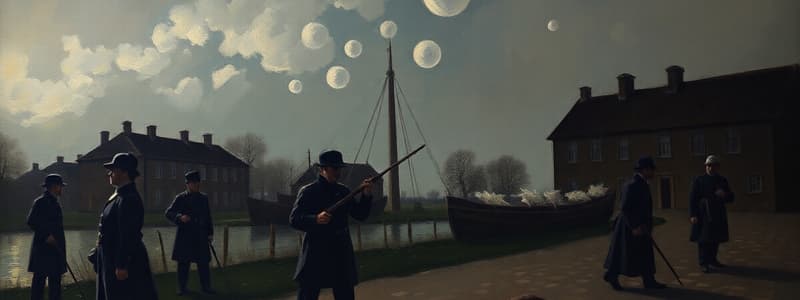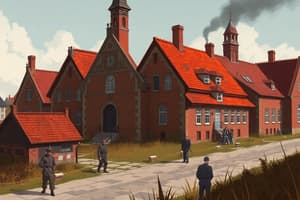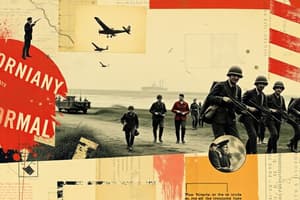Podcast
Questions and Answers
What was the primary purpose of the powder created by Swedish scientists during the Nazi occupation, as described in the text?
What was the primary purpose of the powder created by Swedish scientists during the Nazi occupation, as described in the text?
- To attract police dogs to specific locations, leading them away from areas where individuals were hiding.
- To poison police dogs, thus reducing their effectiveness in locating hidden individuals.
- To create a temporary numbing effect on police dogs' noses, preventing them from detecting hidden individuals. (correct)
- To enhance the sense of smell in police dogs, making it easier for them to locate hidden individuals.
Why did seeing the photograph of Kim Malthe-Bruun have such a profound effect on the author?
Why did seeing the photograph of Kim Malthe-Bruun have such a profound effect on the author?
- The photograph was taken shortly before his execution and was a stark reminder of the brutality of the Nazi regime.
- The photograph reminded the author of someone they knew personally who had suffered during the war.
- His youth and the quiet determination in his eyes made the author determined to tell his story and that of the Danish people. (correct)
- The photograph was accompanied by a detailed account of the tortures he endured, which deeply disturbed the author.
What was Kim Malthe-Bruun's central message in his letter written the night before his execution?
What was Kim Malthe-Bruun's central message in his letter written the night before his execution?
- To create an ideal of human decency, free from narrow-mindedness and prejudice. (correct)
- To focus on individual survival and self-preservation in the face of adversity.
- To seek revenge against those who had perpetrated the war and caused so much suffering.
- To return to the pre-war status quo and rebuild society as it once was.
The author explicitly draws a parallel between Peter Nielsen and whom?
The author explicitly draws a parallel between Peter Nielsen and whom?
What specific effect did the author hope the story of Denmark and its people would have on readers?
What specific effect did the author hope the story of Denmark and its people would have on readers?
What was the primary function of handkerchiefs during the rescue operations in Denmark?
What was the primary function of handkerchiefs during the rescue operations in Denmark?
What detail about the Danish Resistance is emphasized in the content?
What detail about the Danish Resistance is emphasized in the content?
How does the author illustrate the potential for desensitization when repeatedly encountering accounts of bravery and suffering?
How does the author illustrate the potential for desensitization when repeatedly encountering accounts of bravery and suffering?
What does the act of neighbors tending to the homes of the Jewish families who fled Copenhagen symbolize in the immediate aftermath of the war's end?
What does the act of neighbors tending to the homes of the Jewish families who fled Copenhagen symbolize in the immediate aftermath of the war's end?
How does the narrative juxtapose the collective joy of Denmark's liberation with the personal grief experienced by Annemarie and her family?
How does the narrative juxtapose the collective joy of Denmark's liberation with the personal grief experienced by Annemarie and her family?
Considering Peter's final letter, why might its message of love, fearlessness, and pride be particularly poignant in the context of the Nazis' refusal to return his body for burial?
Considering Peter's final letter, why might its message of love, fearlessness, and pride be particularly poignant in the context of the Nazis' refusal to return his body for burial?
What is the most likely reason that Lise kept her involvement in the Resistance a secret from her family?
What is the most likely reason that Lise kept her involvement in the Resistance a secret from her family?
How does the revelation of Lise's involvement in the Resistance alter Annemarie's understanding of her sister and the events surrounding her death?
How does the revelation of Lise's involvement in the Resistance alter Annemarie's understanding of her sister and the events surrounding her death?
Considering the historical context of the Nazi occupation of Denmark, what could be the deeper significance of marking the graves of executed Resistance members with only numbers?
Considering the historical context of the Nazi occupation of Denmark, what could be the deeper significance of marking the graves of executed Resistance members with only numbers?
The passage states, "Even Kirsti was growing up; no longer was she a lighthearted chatterbox of a child. Now she was taller, more serious, and very thin. She looked like the pictures of Lise at seven, in the old album." How does this description of Kirsti contribute to the overall themes of the novel?
The passage states, "Even Kirsti was growing up; no longer was she a lighthearted chatterbox of a child. Now she was taller, more serious, and very thin. She looked like the pictures of Lise at seven, in the old album." How does this description of Kirsti contribute to the overall themes of the novel?
In the broader context of the novel, what does the act of raising the Danish flag in nearly every window, including those of empty apartments, signify about the spirit of the Danish people?
In the broader context of the novel, what does the act of raising the Danish flag in nearly every window, including those of empty apartments, signify about the spirit of the Danish people?
What motivated the Danish people, including King Christian X, to surrender to Germany in 1940, as explained in the text?
What motivated the Danish people, including King Christian X, to surrender to Germany in 1940, as explained in the text?
How did the German official G.F. Duckwitz contribute to the rescue of the Jewish population in Denmark during World War II?
How did the German official G.F. Duckwitz contribute to the rescue of the Jewish population in Denmark during World War II?
Why does Annemarie decide to wear Ellen's Star of David necklace herself until Ellen returns?
Why does Annemarie decide to wear Ellen's Star of David necklace herself until Ellen returns?
What does the act of the Danish people sinking their own navy in Copenhagen harbor in 1943 signify?
What does the act of the Danish people sinking their own navy in Copenhagen harbor in 1943 signify?
How does the author use the character of Annemarie Johansen to convey the broader historical events of the German occupation of Denmark?
How does the author use the character of Annemarie Johansen to convey the broader historical events of the German occupation of Denmark?
What can be inferred about the role of the Danish government during the German occupation based on the information provided?
What can be inferred about the role of the Danish government during the German occupation based on the information provided?
Considering the risks involved, what does the willingness of the Danish people to hide and help smuggle nearly the entire Jewish population to Sweden suggest about their national character?
Considering the risks involved, what does the willingness of the Danish people to hide and help smuggle nearly the entire Jewish population to Sweden suggest about their national character?
What is the significance of the detail that the yellow dress, which once belonged to Lise, has begun to fade and discolor?
What is the significance of the detail that the yellow dress, which once belonged to Lise, has begun to fade and discolor?
How does the author integrate factual historical elements with fictional narrative to enhance the story's credibility and emotional impact?
How does the author integrate factual historical elements with fictional narrative to enhance the story's credibility and emotional impact?
What is the underlying significance of Annemarie's question, 'They didn't shoot Lise, did they?' at the beginning of the chapter?
What is the underlying significance of Annemarie's question, 'They didn't shoot Lise, did they?' at the beginning of the chapter?
Considering Papa's ability to fix Ellen's Star of David necklace, what deeper meaning might this seemingly simple act hold within the context of the story?
Considering Papa's ability to fix Ellen's Star of David necklace, what deeper meaning might this seemingly simple act hold within the context of the story?
How does the author use the contrasting imagery of the dancing crowd in the street and Annemarie's solitary reflection with Lise's yellow dress to highlight the complex emotional landscape of wartime Copenhagen?
How does the author use the contrasting imagery of the dancing crowd in the street and Annemarie's solitary reflection with Lise's yellow dress to highlight the complex emotional landscape of wartime Copenhagen?
What does the author's dedication of the book to Annelise Platt, her friend who was a child in Copenhagen during the German occupation, suggest about the nature of the story she is telling?
What does the author's dedication of the book to Annelise Platt, her friend who was a child in Copenhagen during the German occupation, suggest about the nature of the story she is telling?
Given the information about Peter's involvement in secret meetings and his injury, what can be inferred about Lise's involvement in the resistance movement?
Given the information about Peter's involvement in secret meetings and his injury, what can be inferred about Lise's involvement in the resistance movement?
How does the detail about Peter wearing a coat and hat to hide his bandaged arm and red hair contribute to the story's atmosphere of tension and suspense?
How does the detail about Peter wearing a coat and hat to hide his bandaged arm and red hair contribute to the story's atmosphere of tension and suspense?
Flashcards
Danish Liberation Day
Danish Liberation Day
The day when World War II ended, marked by church bells, the Danish flag being raised, and public celebrations.
National Anthem Significance
National Anthem Significance
The Danish national anthem, sung in the streets as a sign of unity and freedom.
Empty Apartment Symbolism
Empty Apartment Symbolism
Neighbors caring for the homes of Jewish families who had to flee during the war, symbolizing friendship and solidarity.
Symbol of Freedom
Symbol of Freedom
Signup and view all the flashcards
Peter Nielsen's Fate
Peter Nielsen's Fate
Signup and view all the flashcards
Peter's Last Letter
Peter's Last Letter
Signup and view all the flashcards
Lise's Resistance Role
Lise's Resistance Role
Signup and view all the flashcards
Ryvangen
Ryvangen
Signup and view all the flashcards
Rabbit's Blood and Cocaine Powder
Rabbit's Blood and Cocaine Powder
Signup and view all the flashcards
Danish Resistance
Danish Resistance
Signup and view all the flashcards
Kim Malthe-Bruun
Kim Malthe-Bruun
Signup and view all the flashcards
Ideal of Human Decency
Ideal of Human Decency
Signup and view all the flashcards
Resistance Movements
Resistance Movements
Signup and view all the flashcards
The routineness of courage
The routineness of courage
Signup and view all the flashcards
The handkerchief
The handkerchief
Signup and view all the flashcards
Dogs Smell
Dogs Smell
Signup and view all the flashcards
Lise's Death
Lise's Death
Signup and view all the flashcards
Peter's Injury
Peter's Injury
Signup and view all the flashcards
Dancing Memory
Dancing Memory
Signup and view all the flashcards
Hidden Necklace
Hidden Necklace
Signup and view all the flashcards
Broken Clasp
Broken Clasp
Signup and view all the flashcards
Return the Star
Return the Star
Signup and view all the flashcards
Wearing the Star
Wearing the Star
Signup and view all the flashcards
Fictional Annemarie
Fictional Annemarie
Signup and view all the flashcards
Annelise's Stories
Annelise's Stories
Signup and view all the flashcards
Danish Surrender
Danish Surrender
Signup and view all the flashcards
King's Ride
King's Ride
Signup and view all the flashcards
Sinking the Navy
Sinking the Navy
Signup and view all the flashcards
Rabbi's Warning
Rabbi's Warning
Signup and view all the flashcards
G.F. Duckwitz
G.F. Duckwitz
Signup and view all the flashcards
Smuggling to Sweden
Smuggling to Sweden
Signup and view all the flashcards
Study Notes
- The war ended almost two years later, and Annemarie was twelve.
- Church bells rang, and the Danish flag was raised everywhere in Copenhagen.
- People stood in the streets and wept as they sang the national anthem.
- Annemarie, with her family, watched from their balcony, seeing flags in almost every window.
- Many apartments had been empty for two years, with neighbors caring for them for the Jewish families who had fled.
- Mrs. Johansen was tearful, and Kirsti, now taller and more serious, waved a flag.
- Kirsti resembled Lise at seven years old.
- Peter Nielsen had been captured and executed by the Germans in Ryvangen, Copenhagen.
- Peter wrote a letter from prison, expressing his love, lack of fear, and pride in fighting for his country and freedom.
- He requested to be buried beside Lise, but the Nazis buried the executed men in unmarked graves.
- Annemarie's family laid flowers at the numbered ground where Peter was buried.
- Annemarie's parents revealed that Lise was part of the Resistance.
- Lise did not tell her parents, but Peter informed them after her death.
- Lise died when the Nazis raided a cellar where the Resistance held secret meetings.
- Lise was not shot; she was run down by a military car.
- Peter was shot in the arm during the raid but wore a bandage and hat to conceal his injury.
- Annemarie remembered Lise dancing with Peter on their engagement night.
- Annemarie found Ellen's Star of David necklace in the pocket of Lise's yellow dress in a trunk.
- The yellow dress had begun to fade.
- Annemarie asked her father to fix the broken clasp of the necklace so she could return it to Ellen upon her return.
- Until Ellen returns Annemarie will wear it herself.
Afterword
- Annemarie Johansen is a fictional character created from stories told by Annelise Platt, who was a child in Copenhagen during the German occupation.
- The book is dedicated to Annelise Platt.
- The author was moved by the courage and integrity of the Danish people and their king, Christian X.
- Denmark surrendered to Germany in 1940 because it was small and undefended.
- King Christian X rode his horse unguarded every morning, greeting his people.
- In August 1943, the Danes sank their navy in Copenhagen harbor to prevent the Germans from using the ships.
- In 1943, Jews were warned of being taken and "relocated" by the Germans.
- G.F. Duckwitz, a German official, informed the Danish government, who then warned the Jewish community.
- The Danish people took in, fed, clothed, and hid Jewish people, helping them escape to Sweden.
- Almost the entire Jewish population of Denmark, nearly seven thousand people, was smuggled to Sweden.
- Swedish scientists created a powder of dried rabbit's blood and cocaine for handkerchiefs used on fishing boats. The blood attracted the dogs and the cocaine numbed their noses.
- The Danish Resistance was composed of young and brave individuals.
- Peter Nielsen represents those courageous and idealistic young people who died at the hands of the enemy.
- Kim Malthe-Bruun was a young man captured and executed by the Nazis.
- Kim Malthe-Bruun wrote a letter to his mother the night before his death, urging people to dream of creating an ideal of human decency.
- The gift of a world of human decency is what all countries hunger for.
Studying That Suits You
Use AI to generate personalized quizzes and flashcards to suit your learning preferences.




